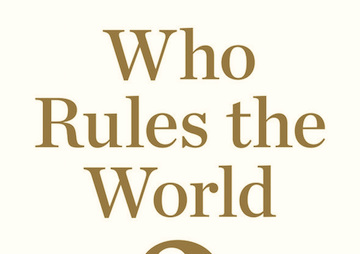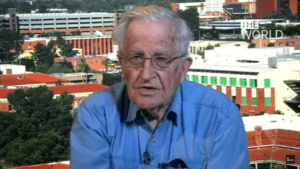The Costs of Violence: Masters of Mankind (Part 2)
Returning to the opening question “Who rules the world?” we might also want to pose another question: “What principles and values rule the world?” 1
2
1
2

Metropolitan Books
This piece, the second of two parts, is excerpted from Noam Chomsky’s new book, Who Rules the World? (Metropolitan Books) and first appeared at TomDispatch. Part 1 can be found by clicking here.
In brief, the Global War on Terror sledgehammer strategy has spread jihadi terror from a tiny corner of Afghanistan to much of the world, from Africa through the Levant and South Asia to Southeast Asia. It has also incited attacks in Europe and the United States. The invasion of Iraq made a substantial contribution to this process, much as intelligence agencies had predicted. Terrorism specialists Peter Bergen and Paul Cruickshank estimate that the Iraq War “generated a stunning sevenfold increase in the yearly rate of fatal jihadist attacks, amounting to literally hundreds of additional terrorist attacks and thousands of civilian lives lost; even when terrorism in Iraq and Afghanistan is excluded, fatal attacks in the rest of the world have increased by more than one-third.” Other exercises have been similarly productive.
A group of major human rights organizations — Physicians for Social Responsibility (U.S.), Physicians for Global Survival (Canada), and International Physicians for the Prevention of Nuclear War (Germany) — conducted a study that sought “to provide as realistic an estimate as possible of the total body count in the three main war zones [Iraq, Afghanistan, and Pakistan] during 12 years of ‘war on terrorism,'” including an extensive review “of the major studies and data published on the numbers of victims in these countries,” along with additional information on military actions. Their “conservative estimate” is that these wars killed about 1.3 million people, a toll that “could also be in excess of 2 million.” A database search by independent researcher David Peterson in the days following the publication of the report found virtually no mention of it. Who cares?
More generally, studies carried out by the Oslo Peace Research Institute show that two-thirds of the region’s conflict fatalities were produced in originally internal disputes where outsiders imposed their solutions. In such conflicts, 98% of fatalities were produced only after outsiders had entered the domestic dispute with their military might. In Syria, the number of direct conflict fatalities more than tripled after the West initiated air strikes against the self-declared Islamic State and the CIA started its indirect military interference in the war — interference which appears to have drawn the Russians in as advanced US antitank missiles were decimating the forces of their ally Bashar al-Assad. Early indications are that Russian bombing is having the usual consequences.
The evidence reviewed by political scientist Timo Kivimäki indicates that the “protection wars [fought by ‘coalitions of the willing’] have become the main source of violence in the world, occasionally contributing over 50% of total conflict fatalities.” Furthermore, in many of these cases, including Syria, as he reviews, there were opportunities for diplomatic settlement that were ignored. That has also been true in other horrific situations, including the Balkans in the early 1990s, the first Gulf War, and of course the Indochina wars, the worst crime since World War II. In the case of Iraq the question does not even arise. There surely are some lessons here.
The general consequences of resorting to the sledgehammer against vulnerable societies comes as little surprise. William Polk’s careful study of insurgencies, Violent Politics, should be essential reading for those who want to understand today’s conflicts, and surely for planners, assuming that they care about human consequences and not merely power and domination. Polk reveals a pattern that has been replicated over and over. The invaders — perhaps professing the most benign motives — are naturally disliked by the population, who disobey them, at first in small ways, eliciting a forceful response, which increases opposition and support for resistance. The cycle of violence escalates until the invaders withdraw — or gain their ends by something that may approach genocide.
Playing by the Al-Qaeda Game Plan
Obama’s global drone assassination campaign, a remarkable innovation in global terrorism, exhibits the same patterns. By most accounts, it is generating terrorists more rapidly than it is murdering those suspected of someday intending to harm us — an impressive contribution by a constitutional lawyer on the 800th anniversary of Magna Carta, which established the basis for the principle of presumption of innocence that is the foundation of civilized law.
Another characteristic feature of such interventions is the belief that the insurgency will be overcome by eliminating its leaders. But when such an effort succeeds, the reviled leader is regularly replaced by someone younger, more determined, more brutal, and more effective. Polk gives many examples. Military historian Andrew Cockburn has reviewed American campaigns to kill drug and then terror “kingpins” over a long period in his important study Kill Chain and found the same results. And one can expect with fair confidence that the pattern will continue.
No doubt right now U.S. strategists are seeking ways to murder the “Caliph of the Islamic State” Abu Bakr al-Baghdadi, who is a bitter rival of al-Qaeda leader Ayman al-Zawahiri. The likely result of this achievement is forecast by the prominent terrorism scholar Bruce Hoffman, senior fellow at the U.S. Military Academy’s Combating Terrorism Center. He predicts that “al-Baghdadi’s death would likely pave the way for a rapprochement [with al-Qaeda] producing a combined terrorist force unprecedented in scope, size, ambition and resources.”
Polk cites a treatise on warfare by Henry Jomini, influenced by Napoleon’s defeat at the hands of Spanish guerrillas, that became a textbook for generations of cadets at the West Point military academy. Jomini observed that such interventions by major powers typically result in “wars of opinion,” and nearly always “national wars,” if not at first then becoming so in the course of the struggle, by the dynamics that Polk describes. Jomini concludes that “commanders of regular armies are ill-advised to engage in such wars because they will lose them,” and even apparent successes will prove short-lived.
Careful studies of al-Qaeda and ISIS have shown that the United States and its allies are following their game plan with some precision. Their goal is to “draw the West as deeply and actively as possible into the quagmire” and “to perpetually engage and enervate the United States and the West in a series of prolonged overseas ventures” in which they will undermine their own societies, expend their resources, and increase the level of violence, setting off the dynamic that Polk reviews.
Scott Atran, one of the most insightful researchers on jihadi movements, calculates that “the 9/11 attacks cost between $400,000 and $500,000 to execute, whereas the military and security response by the U.S. and its allies is in the order of 10 million times that figure. On a strictly cost-benefit basis, this violent movement has been wildly successful, beyond even Bin Laden’s original imagination, and is increasingly so. Herein lies the full measure of jujitsu-style asymmetric warfare. After all, who could claim that we are better off than before, or that the overall danger is declining?”
And if we continue to wield the sledgehammer, tacitly following the jihadi script, the likely effect is even more violent jihadism with broader appeal. The record, Atran advises, “should inspire a radical change in our counter-strategies.”
Your support matters…Independent journalism is under threat and overshadowed by heavily funded mainstream media.
You can help level the playing field. Become a member.
Your tax-deductible contribution keeps us digging beneath the headlines to give you thought-provoking, investigative reporting and analysis that unearths what's really happening- without compromise.
Give today to support our courageous, independent journalists.






You need to be a supporter to comment.
There are currently no responses to this article.
Be the first to respond.